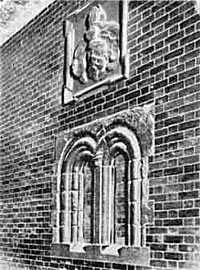< Previous | Contents | Next >
Norman arches, Broadway
 |
THE Norman Arches here shown, which are built for preservation into a perfectly modern brick wall of an entrance on the south side of Broadway, in the Nottingham Lace Market, are most probably the oldest architectural fragments remaining in the City of Nottingham.
The details of their enrichment show them to date from the early days of the Twelfth Century. That is to say, sometime about 1110. It is very difficult, indeed, to assign an origin to them. For a long time it was thought that they were part of the old rectory house of St. Mary’s Church, which centuries ago stood upon the site now occupied by Broadway.
But the more probable theory is that they are stray pieces of the old Norman Church of St. Mary. We know that a Church of St. Mary existed within about twenty years of the Conquest, and there is a rather strong probability that this church was the successor of one which had served the Saxon town of Nottingham for generations before the Conquest.
Upon several occasions it was very badly damaged by fire, and particularly so in the last quarter of the twelfth Century, about 1171.
It is a curious fact that this window was reproduced almost in facsimile on one of the panels in Lenton font, where it is used to illuminate a building which is supposed to represent either the Church of the Holy Sepulchre at Jerusalem, or the room in which the Sacrament of the Last Supper was instituted.
The coat of arms above these arches is that of the Plumtre family. Probably it originally decorated the facade of Plumtre house, which stood on this site till the middle of last century, and the arms have been built into this wall for preservation and memorial.
